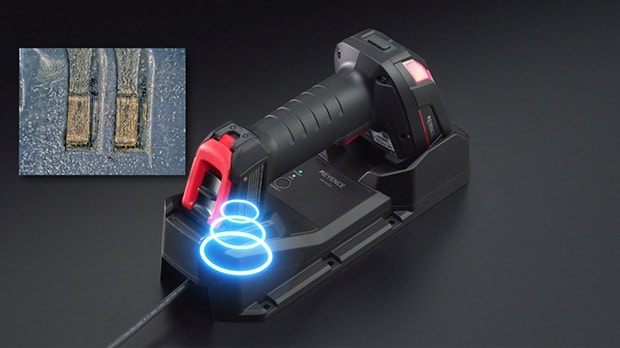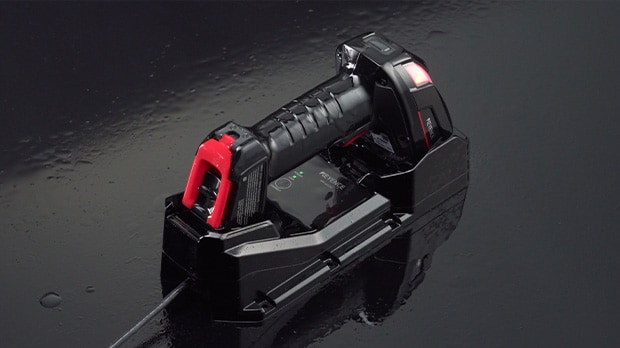Handheld Scanners
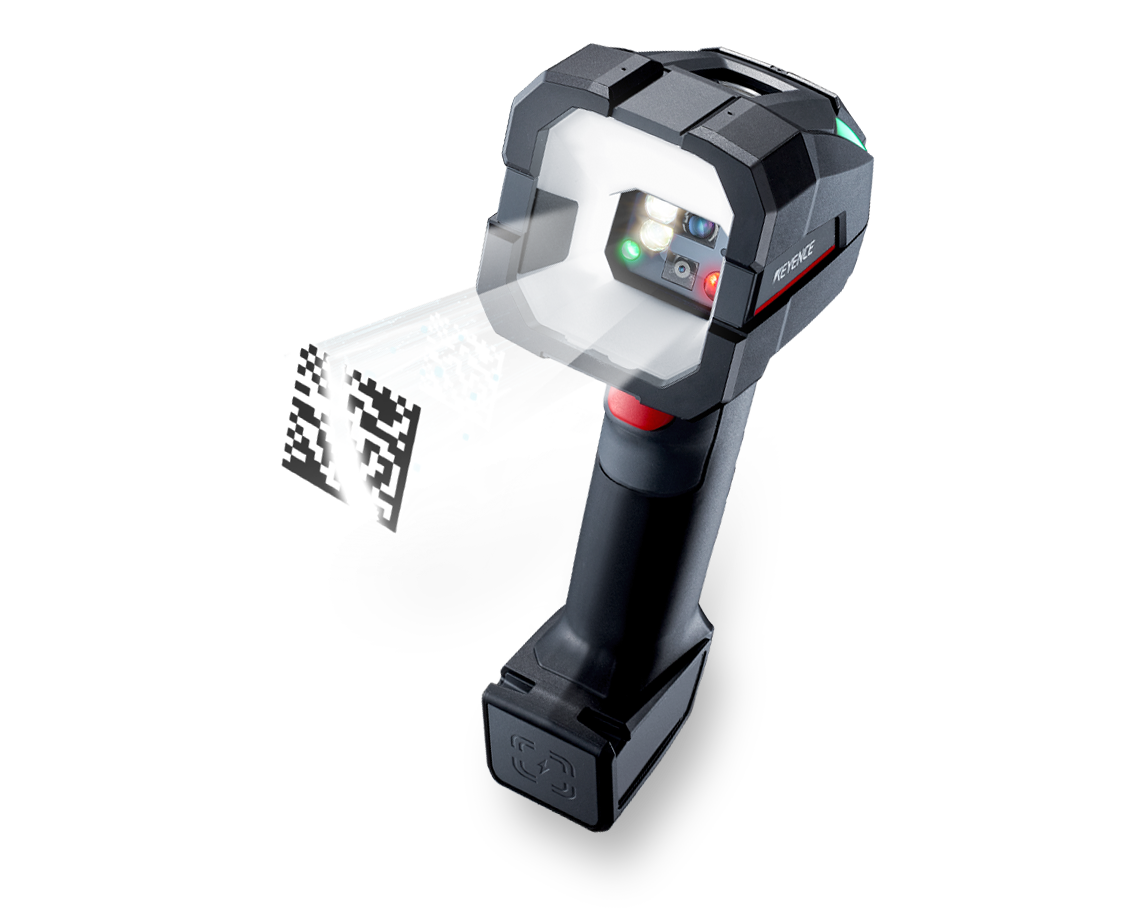
KEYENCE handheld scanners provide even faster reading with advanced reading performance and ultra-durability withstanding harsh working environments. With high-speed responses faster than ever before, these scanners improve operability everywhere from reading challenging codes at manufacturing sites to reading large quantities of barcode labels at logistics sites. Whether you are reading DPM or labels, our lineup is sure to have the optimal model for your situation.
Product Lineup

KEYENCE’s HR-X Series of rugged industrial handheld code readers offers ultra-durability and high performance even in harsh work environments thanks to an IP65/67G enclosure rating, and impressive reading performance for improved efficiency. The durable design eliminates the most common causes of failures such as water and oil adhesion, drops and repeated drops, and terminal wear for usability in any working environment—from the harsh conditions of manufacturing sites to logistics sites where repeated impacts are common. The AI-enhanced multi-core decoder also offers drastically improved reading performance for difficult-to-read DPM codes in addition to greater flexibility with codes read at a distance or at an angle. With reliable reading of even the most challenging codes, faster operations even with time-consuming tasks, and a significantly longer service life, the HR-X Series improves on-site efficiency and reduces costs at the same time.
Features
Instantaneous, Reliable Reading of Challenging DPM Codes
Advanced reading performance is made possible with the direct, polarized, and diffused lighting developed for SR-X Series fixed code readers.
The AI-enhanced decoder also drastically improves reading performance with challenging DPM codes. This provides instantaneous and reliable reading even with damaged codes, highly reflective targets, and incredibly small codes. Reading flexibility is also improved for long-distance reading and reading at an angle, significantly reducing the need to retry codes from a different angle or distance to ensure accurate traceability for greater productivity.
Glare

Rough Backgrounds

Defective Codes

Ultra-Low Contrast

Dirty Code

Uneven Module Color

Scratches

Dot Marking

Faster Reading Performance for Codes from Near and Far Improves Efficiency
The dual-camera structure results in high-speed reading over a large depth of field for codes both near and far away. With no need to adjust the reading distance, users need only point the easy-to-align aimer at the target code, which helps eliminate extended hours spent on reading. This also makes it possible to reduce the time spent on manual operations requiring reading of numerous codes, in turn helping to improve on-site efficiency.
Industrial-Grade Durability
The durable design eliminates the most common causes of failures, such as water and oil adhesion and damage from drops, for usability in any working environment—from the harsh conditions of manufacturing sites to logistics sites where repeated impacts are common. In addition to eliminating the need for maintenance and replacement due to damage, the rugged design also helps ensure high-performance reading over a longer usage period.
- High oil resistance thanks to an IP65/67G and ISO 16750-1–compliant enclosure
- Drop resistance: 2.5 m 8.2' / Repeated drop resistance: 20,000 drops (30 cm 11.81")*
* These are test values and are not guaranteed
Wireless Charging Eliminates Terminal Wear
Wireless charging support means there’s no need to worry about terminal wear, helping to ensure a long, reliable service life. This also eliminates the need for terminal maintenance and cleaning while ensuring safe, reliable charging even in dirty and oily environments.
No terminal wear
Oily environments
Dirty environments
Three Models to Choose from According to the Application
Choose from three different handheld code reader models according to the reading target, reading distance, and intended application. Each model boasts a rugged IP65/67G design. Both the DPM and High Performance models include a built-in display that makes checking reading results and changing settings incredibly easy.
DPM Model

HR-X500 / HR-X500WB
Instantaneous reading of challenging DPM and miniscule codes.
High Performance Model
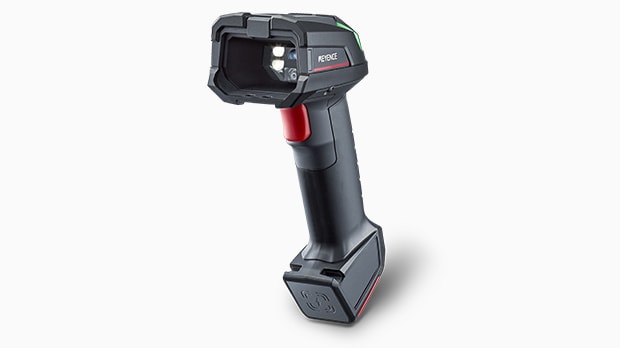
HR-X300 / HR-X300WB
High-speed reading & large depth of field for stable reading of simple DPM.
Standard Model

HR-X100 / HR-X100WB / HR-X100ESD
Lightweight and durable with impressive performance even for challenging codes. ESD-safe model is also available.

The SR-G100 Series handheld DPM code reader features fast scanning and reading stability. This series offers (1) user-friendliness in terms of easy handling owing to wireless connection along with simple setup and operations and (2) a high level of barcode/2D code reading performance. Operators can use the automatic calibration function to scan and configure settings with just the press of a button. This series is also equipped with a multi-lighting control function, which automatically selects the most suitable lighting from the different colors, polarized, multi-angle, and partial lighting options. This function also removes glare and enables the stable reading of challenging codes on metal or black plastic cylinders and dot peen marking on casting surfaces. The ergonomically designed body and optimal center-of-gravity design allow the user to immediately hold this series at the best angle and position, improving work efficiency.

Take advantage of long-term usability with a rugged, robust design. In addition to a drop resistance of 2.0 m (6.6′) and repeated drop resistance of 20,000 drops, the HR-70 Series was designed to withstand more than 10 million trigger actions and 100,000 cable bends for reliable use with minimal wear and tear. High-speed reading of challenging codes, and high-speed, high-capacity data transfers greatly improve work efficiency. A wide range of peripheral equipment and advanced software allow for easy usability in any situation with significantly easier installation and operation.
Features
Robust Design for Long-Term Usability
Highly Resistant to Impacts From Drops
Designed to withstand a variety of impacts, the robust HR-70 Series eliminates the most common causes of failure, ensuring reliable long-term usability.
The rugged design is capable of withstanding drops from 2 m (6.6′) as well as 20,000 repeated impacts from 30 cm (11.81″).
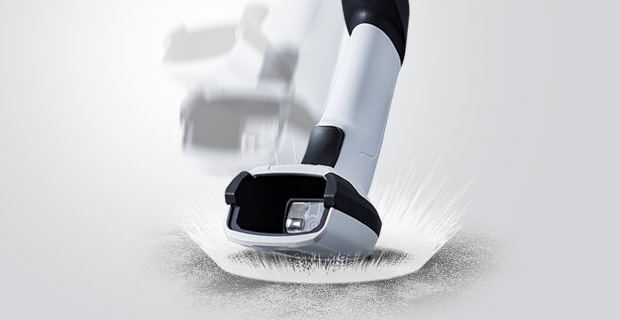
Reliable with Minimal Wear and Tear
The HR-70 Series was designed with careful consideration for the causes of failure for parts prone to breaking, ensuring reliable long-term usability.
Trigger Actions: 10 Million

Cable Bends: 100,000

High-Speed Performance for Improved Work Efficiency
Take advantage of fast reading of all kinds of codes to improve work efficiency.

High-Speed Reading of Challenging Codes

High-speed reading is possible with challenging codes, including codes behind plastic wrapping and distorted or dirty codes.
High-Speed, High-Capacity Data Transfer
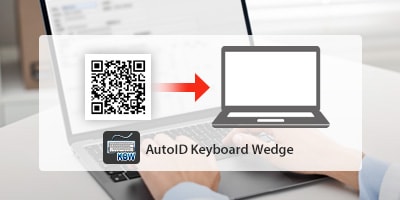
Even codes with lots of information can be instantly imported and quickly transferred to a PC, significantly decreasing input times and increasing efficiency.
Fast Reading of Codes on LCD Screens
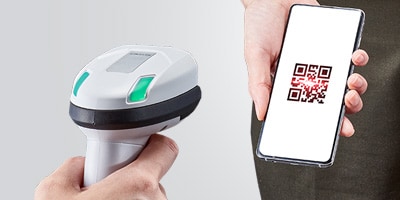
Codes on LCD screens can be easily read for applications such as barcode payments and point accumulation apps.
Discontinued Series
KEYENCE handheld scanners can be held in a single hand to read barcodes and 2D codes and import information into PCs and similar devices. Some scanners are specialized for reading barcodes. Other scanners support the reading of both barcodes and 2D codes. The target is exposed to a laser or LED, and the reflected light is received by a CMOS or CCD to read the code.
A diverse variety of reading devices including fixed mount code readers and handheld computers is available, but the major difference between these devices and handheld scanners is that the latter is specialized for reading codes with the scanner held in the operator’s hands. Therefore, most handheld scanners are smaller and lighter than other reading devices to prioritize ease of handling during work. Also, the purpose of handheld scanners is to transmit the read information to the connected device or software without using a terminal to perform programming or write information for the work application, which is different from handheld computers. Therefore, handheld scanners are normally operated with a simple mechanism such as a trigger switch or button. In most situations, handheld scanners are held in a single hand when used, but they may also be used in a hands-free orientation where they are mounted on a stand to read targets as they pass by. The read information is transmitted and applied to software or a connected work system for production or inventory control via a connected PC, PLC, or other such device. This information is also transmitted and applied to POS systems and similar systems via in-store POS registers.
Types and Features of Handheld Scanners
Handheld scanners are grouped into two main types according to the codes they can read. These types can be further subdivided according to the applications and reading methods (light source, light-receiving element, etc.).
Handheld Barcode/2D Code Scanners
These handheld scanners can read not just barcodes (1D codes) in various standards but also 2D codes such as QR codes, DataMatrix codes, and PDF417. One feature of these scanners is that they have a detection area that is larger than that of handheld barcode scanners specialized for reading barcodes. Therefore, they commonly use a high-intensity LED for the light source and receive reflected light with a CMOS (Complementary Metal Oxide Semiconductor), transmitting the information decoded according to the standard to the connected device. Some scanners can even read multiple barcodes and 2D codes in the detection area as a batch. These devices are mainly separated into two types, one that supports manufacturing sites and other such harsh environments and one that emphasizes versatility and work efficiency.
Industrial handheld code readers
At manufacturing sites, DPM (direct part marking), in which parts or modules are marked directly with 2D codes or similar information, is used to manage parts, prevent the mixing of different types of parts, and support traceability during manufacturing. Although DPM allows for reasonable part management, the materials of the targets make it necessary to support codes that are difficult to read due to various surface conditions such as light reflectance and absorptivity, curved surfaces, and surface roughness. Therefore, handheld scanners that can support diverse lighting conditions are effective in industrial applications. These devices must also be durable enough to withstand harsh environments.
Compact and lightweight type
This type refers to the handheld barcodes/2D code scanners that emphasize versatility at logistics warehouses, stores, and similar locations. Compared to industrial types that emphasize the reading of difficult-to-read DPM codes and support for harsh environments, these devices have compact and lightweight designs that prioritize ease of handling corresponding to the reading targets. Also, types that can read at high speeds improve work efficiency.
Handheld Barcode Scanners
These handheld scanners are specialized to read barcodes (1D codes) such as JAN/EAN/UPC, Code39, Code128, ITF, industrial 2of5, and NW-7 (Codabar). Normally, barcodes are arranged along the horizontal axis, so structures and principles that match the reading of these codes are used. Two typical types of handheld barcode scanners with different light sources and light-receiving elements are introduced below.
Laser barcode scanners
These handheld barcode scanners are specialized to read barcodes (1D codes) and use a laser for their light source. Generally, the light source is a visible semiconductor laser, and galvano mirrors are used to reflect the laser light to the left and right, illuminating the entire barcode from one end to the other. The diffuse reflected light from the barcode is then received, and its waveform is decoded according to the barcode standard to read the information. The laser light allows for sharp illumination that is not easily affected by the environment, ensuring stable reading in various situations.
CCD barcode scanners
These handheld barcode scanners generally use red LEDs for their light source and CCDs (Charge Coupled Devices) for their image sensor. With no laser emitter and other such moving parts, the light emitted from the LED light source is reflected by mirrors to illuminate the reading target. The result is that the number of scans per second that can be performed is twice that of a laser barcode scanner. Therefore, these devices have excellent barcode reading speed and response.
Benefits of Handheld Scanners
Handheld scanners are used to read barcodes, 2D codes, or both. Handheld scanners specialized for ease of handling and advanced reading performance are effective at improving work efficiency when connected directly to a PC, PLC, POS register, or similar device.
There are also handheld computers used as handheld type reading devices, but using these multi-function handheld computers close to PCs, PLCs (sequencers), and similar devices complicates the system and work. On the other hand, handheld scanners specialized for code reading simplify hardware configurations and improve work efficiency with their compact and lightweight designs that provide excellent ease of handling in reading work. The codes of various standards can be read and arbitrary items of, for example, work systems can be entered. Handheld scanners can be used in a variety of situations such as manufacturing sites, logistics warehouses, retail stores, medical institutions, infrastructure, and amusement facilities, and selecting the scanner specialized for the codes to read leads to improved work efficiency.
Handheld scanners provide substantial performance as devices specialized for reading while held by the operator. You can improve your work efficiency by selecting the handheld scanner that matches your specific purpose, considering factors such as scan speed, response, detection area size, sharpness, and distance to the target.
Because they are simple devices, one of the factors for selecting handheld scanners is their advanced performance matching various applications. The required performance varies depending on the application and also on whether the codes to read are just barcodes (1D codes), just 2D codes, or both. For example, a handheld scanner with a large detection area and a long reading distance is effective at reading barcodes and 2D codes at manufacturing sites. On the other hand, when reading an order book and when performing similar work in which multiple narrow barcodes are read continuously, using triggers to operate a handheld scanner that performs a large number of scans per second with a good response can not only prevent work loss attributable to incorrectly read codes but can also prevent mistakes such as skipped or missed codes.
With multiple connection methods available, handheld scanners can be connected to PCs, PLCs, etc. in a way that matches the connected device. These connection methods include wired connections (USB, RS-232C, and Ethernet) and wireless connections (such as Bluetooth) to match the application.
A USB connection is useful for entering the information read with a handheld scanner into the work system, spreadsheet software, etc. on a PC. Power can be supplied to a handheld scanner via a USB bus, so no external power supply is necessary. Selecting the Ethernet or RS-232C connection method allows for connections to PLCs (sequencers) and other such industrial edge devices. Furthermore, types specialized for RS-232C connections between devices made by the same manufacturer—for example, KEYENCE handheld scanners and PLCs—are available, ensuring even smoother operations. Handheld barcode/2D code scanners can also be connected to wirelessly via Bluetooth. This is effective in obtaining the improvements to workability and work safety that can only be provided by wireless connections.
Handheld Scanners Case Studies
Reading difficult-to-read DPM (direct part marking)

Direct part marking, in which complicated 2D codes are marked directly on parts, is widely used in management and traceability at manufacturing sites. The surfaces of parts are very diverse, so it is hardly uncommon for it to be difficult to read codes with handheld code readers due to surface conditions. SR-G100 Series handheld DPM code readers make use of the algorithm designed for KEYENCE’s latest fixed mount code readers but optimized for handheld types to handle difficult-to-read codes with persistence and speed. Even warped codes on curved surfaces like in image A, codes marked on cutting marks like in image B, and codes marked on uneven surfaces like in image C can be read easily, quickly, stably, and without errors.
Automatic, hands-free reading
KEYENCE’s handheld barcode scanners can easily be used as fixed mount scanners, just set them in the dedicated stand. In automatic scan mode, just move the barcode to read past the scanner to automatically start reading. With handheld and hands-free reading modes, these scanners can be used in a wide variety of situations.
Continuous barcode reading, such as with order books
Target reading mode is useful when trying to continuously read barcodes in an efficient manner, such as with order books. With KEYENCE laser handheld barcode scanners, the laser light is aligned with the barcodes to read, and reading is performed when the trigger switch is pressed. This not only prevents mistakes and missed codes, but allows for stable and fast work when reading a large number of barcodes.
How to Select a Handheld Scanner (General)
Using three different points of view, this section introduces how to select a handheld scanner according to its application and purpose.
1. Selection according to the codes to read
One major point to use in selecting the handheld scanner is whether the codes to read are barcodes (1D codes) or 2D codes.
Reading just barcodes
Handheld barcode scanner (laser/CCD type)
Reading 2D codes
Handheld barcode/2D code scanner (compact and lightweight industrial handheld code reader)
Selecting a handheld barcode/2D code scanner allows you to read not just 2D codes but barcodes as well, eliminating the need to purchase replacement scanners in the future if your current setup of just using barcodes changes to also handle 2D codes. The readable range also increases, leading to greatly improved work efficiency. On the other hand, if you do not need to read anything other than barcodes, selecting a handheld barcode scanner specialized for this purpose provides the benefits that only come with a specialized device such as specifications, cost performance, and work efficiency.
2. Selection according to the usage environment and application
Handheld scanners are used in a wide variety of situations including manufacturing sites, logistics warehouses, retail stores, offices, and medical institutions. KEYENCE’s lineup contains handheld scanners for a variety of usage environments.
Manufacturing sites
It is effective to introduce industrial handheld code readers to read the DPM (direct part marking) codes on parts made of various materials and having various shapes during manufacturing processes. With diverse lighting conditions, it is possible to read codes even if parts have curved or glossy surfaces and even if the light absorptivity or surface roughness varies. These devices also have excellent durability to withstand use in harsh environments.
[Target product]
Handheld DPM Code Reader SR-G100 Series
Retail stores, offices, hospitals, etc.
The space in which to read codes is limited, so selecting a compact and lightweight handheld scanner leads to improved work efficiency. Hence, it is effective to introduce a compact and lightweight handheld barcode scanner or handheld barcode/2D barcode scanner. Furthermore, when selecting a scanner for use in a store or a similar location where aesthetics are important, it is a good idea to select a model with an appealing design.
[Target handheld barcode/2D code scanner]
Handheld Scanner HR-100 Series
Logistics warehouses, offices, etc.
When it is necessary to read many barcodes quickly, the work speed can be improved by using a CCD type handheld barcode scanner, which has excellent high-speed performance. When it is necessary to read 2D codes, selecting a compact, lightweight model leads to improved work efficiency.
[Target handheld barcode/2D code scanner]
Handheld Scanner HR-100 Series
3. Selection according to whether wireless connections are used
At manufacturing sites, the cable of the handheld scanner may get caught due to the environmental conditions of the process, leading to problems and disconnections. Also, in logistics work and work at stores, offices, etc., the cable can get in the way when moving packages and when scanning at a distance from packages. For this type of work environment and details, it is effective to select a handheld scanner that supports wireless connections via Bluetooth.
[Target products for wireless (Bluetooth) connections]
Handheld DPM Code Reader SR-G100 Series
Handheld Scanner HR-100 Series

The “Barcode Information & Tips” site explains the basic principles of barcodes and 2D codes, types of codes, how they work, examples of use, and techniques used for scanning the codes.
Frequently Asked Questions About Handheld Scanners
There are various connection methods, and you can select the right one for your application. Handheld barcode scanners can be easily connected to PCs, PLCs (sequencers), etc. via the highly versatile USB interface (with power supplied from the USB bus) or via the RS-232C interface. You can connect a handheld barcode/2D code scanner to a PC via USB and supply power through this connection as well. RS-232C, Ethernet, PS/2, and similar connections are also supported. You can also quickly connect the scanner to an existing system such as a PLC and an HMI (a touch panel) instead of a PC. When used in combination with a dedicated communication unit, KEYENCE handheld barcode/2D code scanners (the SR-G100 Series/HR-100 Series) can be connected wirelessly over Bluetooth.
KEYENCE provides AutoID Keyboard Wedge, a piece of software that can be used to output the read information in various ways without requiring specialized programming. This software meets diverse needs with some examples including the need to output to Excel just specific parts of the alphanumeric strings indicated by barcodes, the need to replace alphanumeric text with control characters, and the need to convert 2D code control characters to specific keys such as [Tab] and assign these keys to cells. Also, with industrial handheld code readers, the AutoID Network Navigator software can be used to easily configure settings, perform automatic calibration, and display images in real time with Live View on a PC.
At manufacturing sites, fixed mount barcode readers are used as the inline reading devices, but handheld scanners can be used together with these devices to complement management and traceability by recording events outside the line. For example, in machining or assembly processes, if subline work occurs, a worker scanning the DPM on the parts ensures that the process is recorded in its entirety. In inspection processes, when targets found to be defective are repaired in near-line locations, handheld scanners allow that history to be recorded easily. In transportation or shipping processes, handheld scanners can be used to immediately record situations where it is necessary to reload products on the conveyor line due to errors and different products being mixed together. In this way, handheld scanners provide flexible and efficient support for semi-automatic and fully automatic worksites.

